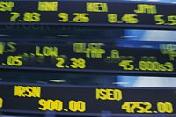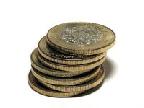
 |
|
| Financial Terms | |
| Yield to call |
|
Information about financial, finance, business, accounting, payroll, inventory, investment, money, inventory control, stock trading, financial advisor, tax advisor, credit.
Main Page: payroll, money, financial, business, tax advisor, stock trading, finance, financial advisor, |
Definition of Yield to call
Yield to callThe percentage rate of a bond or note, if you were to buy and hold the security until the call date.
Related Terms:Yield to worstThe bond yield computed by using the lower of either the yield to maturity or the yield to call Annual percentage yield (APY)The effective, or true, annual rate of return. The APY is the rate actually Bond equivalent yieldBond yield calculated on an annual percentage rate method. Differs from annual Bond-equivalent yieldThe annualized yield to maturity computed by doubling the semiannual yield. CallAn option that gives the right to buy the underlying futures contract. Call an optionTo exercise a call option. Call dateA date before maturity, specified at issuance, when the issuer of a bond may retire part of the bond  Call money rateAlso called the broker loan rate , the interest rate that banks charge brokers to finance Call optionAn option contract that gives its holder the right (but not the obligation) to purchase a specified Call priceThe price, specified at issuance, at which the issuer of a bond may retire part of the bond at a Call priceThe price for which a bond can be repaid before maturity under a call provision. Call protectionA feature of some callable bonds that establishes an initial period when the bonds may not be Call provisionAn embedded option granting a bond issuer the right to buy back all or part of the issue prior Call riskThe combination of cash flow uncertainty and reinvestment risk introduced by a call provision. Call swaptionA swaption in which the buyer has the right to enter into a swap as a fixed-rate payer. The CallableA financial security such as a bond with a call option attached to it, i.e., the issuer has the right to  Capital gains yieldThe price change portion of a stock's return. Convenience yieldThe extra advantage that firms derive from holding the commodity rather than the future. Coupon equivalent yieldTrue interest cost expressed on the basis of a 365-day year. Covered callA short call option position in which the writer owns the number of shares of the underlying Covered call writing strategyA strategy that involves writing a call option on securities that the investor Current yieldFor bonds or notes, the coupon rate divided by the market price of the bond. Deferred callA provision that prohibits the company from calling the bond before a certain date. During this Dividend yield (Funds)Indicated yield represents return on a share of a mutual fund held over the past 12 Dividend yield (Stocks)Indicated yield represents annual dividends divided by current stock price. Earnings yieldThe ratio of earnings per share after allowing for tax and interest payments on fixed interest Effective annual yieldAnnualized interest rate on a security computed using compound interest techniques. Effective call priceThe strike price in an optional redemption provision plus the accrued interest to the Equivalent bond yieldAnnual yield on a short-term, non-interest bearing security calculated so as to be Equivalent taxable yieldThe yield that must be offered on a taxable bond issue to give the same after-tax First-callWith CMOs, the start of the cash flow cycle for the cash flow window. Flattening of the yield curveA change in the yield curve where the spread between the yield on a long-term High-yield bondSee:junk bond. Implied callThe right of the homeowner to prepay, or call, the mortgage at any time. Indicated yieldThe yield, based on the most recent quarterly rate times four. To determine the yield, divide Irrational call optionThe implied call imbedded in the MBS. Identified as irrational because the call is Liquid yield option note (LYON)Zero-coupon, callable, putable, convertible bond invented by Merrill Liquid yield option note (LYON)Zero-coupon, callable, putable, convertible bond invented by Merrill Lynch & Co. Margin callA demand for additional funds because of adverse price movement. Maintenance margin Non-parallel shift in the yield curveA shift in the yield curve in which yields do not change by the same Parallel shift in the yield curveA shift in the yield curve in which the change in the yield on all maturities is Provisional call featureA feature in a convertible issue that allows the issuer to call the issue during the noncall Pure yield pickup swapMoving to higher yield bonds. Put-call parity relationshipThe relationship between the price of a put and the price of a call on the same Realized compound yieldyield assuming that coupon payments are invested at the going market interest Relative yield spreadThe ratio of the yield spread to the yield level. Reoffering yieldIn a purchase and sale, the yield to maturity at which the underwriter offers to sell the bonds Required yieldGenerally referring to bonds, the yield required by the marketplace to match available returns Riding the yield curveBuying long-term bonds in anticipation of capital gains as yields fall with the Steepening of the yield curveA change in the yield curve where the spread between the yield on a long-term Uncovered callA short call option position in which the writer does not own shares of underlying stock Weighted average portfolio yieldThe weighted average of the yield of all the bonds in a portfolio. YieldThe percentage rate of return paid on a stock in the form of dividends, or the effective rate of interest Yield curveThe graphical depiction of the relationship between the yield on bonds of the same credit quality Yield curve option-pricing modelsModels that can incorporate different volatility assumptions along the Yield curve strategiesPositioning a portfolio to capitalize on expected changes in the shape of the Treasury yield curve. Yield ratioThe quotient of two bond yields. Yield spread strategiesStrategies that involve positioning a portfolio to capitalize on expected changes in Yield to maturityThe percentage rate of return paid on a bond, note or other fixed income security if you acid test ratio (also called the quick ratio)The sum of cash, accounts receivable, and short-term marketable dividend yield ratioCash dividends paid by a business over the most net income (also called the bottom line, earnings, net earnings, and netoperating earnings) Bond Equivalent YieldBond yield calculated on an annual percentage rate method Call OptionA contract that gives the holder the right to buy an asset for a Effective Annual YieldAnnualized rate of return on a security computed using compound Yield CurveA graphical representation of the level of interest rates for Yield to MaturityThe measure of the average rate of return that will be earned on a economically reworkedwhen the incremental revenue from the sale of reworked defective units is greater than labor yield variance(standard mix X actual hours X standard rate) - (standard mix X standard hours X standard rate); material yield variance(standard mix X actual quantity X standard price) - (standard mix X standard quantity X standard price); process quality yieldthe proportion of good units that resulted from the activities expended yieldthe quantity of output that results from a specified input yield ratiothe expected or actual relationship between input and output Call a. An option to buy a certain quantity of a stock or commodity for a Callable bondA bond that allows the issuer to buy back the bond at a Par yield curveThe yield curve of bonds selling at par, or face, value. Spot curve, spot yield curveSee Zero curve. Yield a. Measure of return on an investment, stated as a percentage of price. Yield curveGraph of yields (vertical axis) of a particular type of security Yield to maturityA measure of the average rate of return that will be earned Zero curve, zero-coupon yield curveA yield curve for zero-coupon bonds; Production yield varianceThe difference between the actual and budgeted proportions call optionRight to buy an asset at a specified exercise price on or before the exercise date. callable bondBond that may be repurchased by the issuer before maturity at specified call price. current yieldAnnual coupon payments divided by bond price. yield curveGraph of the relationship between time to maturity and yield to maturity. yield to maturityInterest rate for which the present value of the bond’s payments equals the price. Current YieldThe percentage return on a financial asset based on the current price of the asset, without reference to any expected change in the price of the asset. This contrasts with yield-to-maturity, for which the calculation includes expected price changes. See also yield. YieldThe interest rate that makes the present value of a stream of future payments associated with an asset equal to the current price of that asset. Also called yield to maturity. See also current yield. Yield curveA graph showing how the yield on bonds varies with time to maturity. Benchmark interest rateAlso called the base interest rate, it is the minimum interest rate investors will Contract monthThe month in which futures contracts may be satisfied by making or accepting a delivery. Leveraged buyout (LBO)A transaction used for taking a public corporation private financed through the use Net financing costAlso called the cost of carry or, simply, carry, the difference between the cost of financing Option-adjusted spread (OAS)1) The spread over an issuer's spot rate curve, developed as a measure of Price value of a basis point (PVBP)Also called the dollar value of a basis point, a measure of the change in Quality spreadAlso called credit spread, the spread between Treasury securities and non-Treasury securities DurationThe expected life of a fixed-income security considering its coupon Related to : financial, finance, business, accounting, payroll, inventory, investment, money, inventory control, stock trading, financial advisor, tax advisor, credit. |